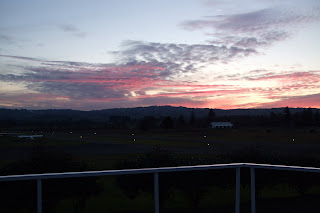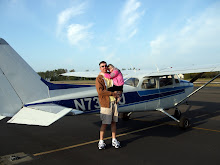 1.5hrs - Solo Short Cross Country!!
1.5hrs - Solo Short Cross Country!!Man, was that awesome!
I arrived out a Twin Oaks about 11:00, so my CFI could look over my flight plan, endorse my logbook, and spend some ground time with me reviewing the NAV/COM, which I've felt a little weak on.
I wasn't scheduled for the aircraft until 1pm, but the reservation before mine cancelled, so I was free to leave when I was ready.
My instructor left, and I was on my own, and I was soon on runway 20, ready for departure. A deep breath to relax a bit, and I was on my takeoff roll and into the air.

A quick look around in disbelief that I was alone in an aircraft, and headed for an airport I've never been to, in a town I've never been to.
I called McMinnville FSS to open my flight plan, but it had not been sent over yet as I was departing more than an hour ahead of time, so I filed a round robin flight plan in-route. I did have to admit to being a student, and not knowing the equipment code, but flight service was very helpful, and I soon had a filed VFR flight plan open.
By the time I reached my cruising altitude of 3500ft, I was all set up with my VOR and GPS, and could relax, check off my checkpoints, listen to CTAF, ATIS, or AWOS of the airports I was near, look for traffic, and enjoy the view of the Willamette Rver Valley spread before me.

Soon it was time to begin my descent, and listen in for traffic at S30 (Lebanon). There was no traffic, so I made my first call, and began maneuvering for a 45 downwind entry for runway 34.
After very decent landing, I taxied off, and decided to follow my CFI's recommendation to shut down, get out and walk around, and enjoy the fact that I'd flown there on my own.
I got out, took a picture of 4KU on the ground at Lebanon, and walked into the FBO. I ended up spending about a half hour talking to a nice old guy about his favorite flying destinations, and the price of fuel. I probably could have easily enjoyed a couple of hours there talking, but decided that I should get headed back.

Once back in the air, I realized that my estimated time in-route on my open flight plan was not going to be enough, so I called and amended it for a later arrival. I was then back to my checkpoints, listening to the radio, and looking about.
Following the Newburg VOR took me right to where I needed to be, and begin my descent to enter the pattern.
The pattern was as good as any I've done, being very watchful of my altitude and airspeed. I was a bit high on final (as always seems to be the case), but trimming for 60kts, full flaps, and coasting in, I was able to bring it down to where I wanted to be. Although I was right at may usual 60kts, I did float quite bit. I was just thinking that another couple of seconds of this and I'd need to go around for another try, when the wheels squeaked.
With a huge grin and a sigh of relief, I cleared 02. All there was to do now was taxi to the pump, close my flight plan, and shut down.
I also finished page three of my logbook with 117 landings, 1.8hrs under the hood, 2.2hrs night, 3.7hrs solo, and 36.3hrs total. Yes there's a lot of logbook left, but a milestone for me anyway.


















